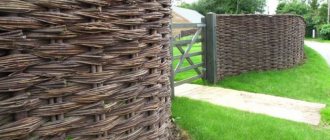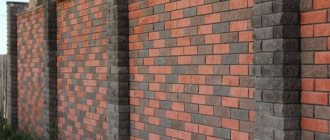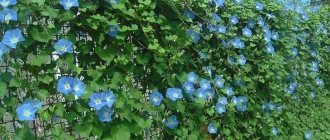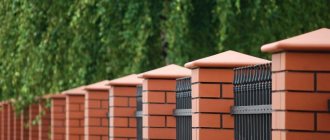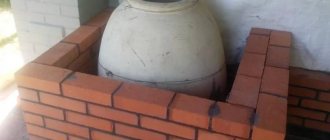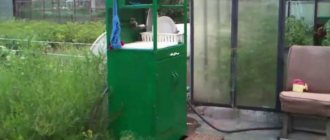Fences and railings are an integral and important element of a country house, cottage, or terrace. They serve as a shelter from prying eyes and also as a barrier preventing unexpected guests from entering your territory. But fencing and fencing are also intended to serve as a decorative element.
We present to you an exclusive material for the manufacture of fences , fences, flower beds, canopies and partitions - polymer vine made of high-strength polyethylene. From such a vine you can weave various options for fences and fences in length and height, as well as various other structures, including complex shapes (for example, wicker outdoor furniture). In addition to wicker fence sections , they can be equipped with various gates and wickets.
Products made from wicker have existed since ancient times. Currently, in the era of creating a large number of polymer and composite materials, interest in wicker barriers made of composites is quite high. On the one hand, simplicity, and on the other, aesthetics and original appearance, they harmoniously fit into any interior style, both inside and outside the building.
The main advantages of DeckWOOD artificial wicker fences:
- natural appearance;
- aesthetics;
- absolute moisture resistance;
- high resistance to mechanical damage;
- do not rot - do not dry out;
- absence of knots and splinters;
- resistance to fungus;
- resistance to insects;
- UV resistance;
- temperature range of use from - 50 to +75 degrees;
- does not require maintenance, impregnation or painting (painted in the paste);
- durability.
Wicker fence sections are made of a metal frame, painted with a polymer coating and braided with polymer wicker.
Sections are manufactured according to the customer’s specified dimensions, all joining and mounting parts are also developed and manufactured based on the technical specifications. The metal frame is powder coated in the color desired by the customer (RAL color chart).
The cost varies depending on the purpose, load and type of weaving.
Scope of application
Systems of fence sections will help you delimit the territory and give it an extraordinary appearance. Sections are supplied as ready-made sections or made to order, and they are also equipped with various gates, wickets and other additional elements. Providing convenient access to your areas while maintaining the overall design concept.
Separate elements allow you to delimit different zones both at home and in a cafe or restaurant ; convenient canopy designs will allow you to create shade and comfort in hot weather. Partitions can be solid from the ceiling to the floor, in order to clearly separate the space, or light and openwork, in order to only outline the boundaries between zones.
The specific properties of the material allow the use of vines as decorative elements and small forms such as flower beds, fences, garden stands, sheds, gazebos, and much more!
Wicker fencing DeckWOOD
| from 4700 ₽/m² | To order |
| Section length: | from 500 mm to 4000 mm |
| Section width: | from 500 mm to 4000 mm |
| Rod diameter: | 18 mm |
| In 1 sq.m. rods: | 56 pcs |
| Frame color options | Vine color options |
- Description
- Technical information
- Catalogs and instructions
- Delivery
- Installation and design
Tips and tricks
- Before starting work, you must carefully study the nuances of working with wood of the selected type.
- You should clearly determine the location of the fence and calculate the amount of material needed.
- The lifespan of the fence depends on how strong the supporting structure is. It is advisable to use metal supports.
- It is better to install the fence in sections so that if damaged they can be replaced.
- To ensure that the stakes are less subject to wear when in contact with moisture, they are installed in the ground, having first filled the hole with sand.
Description
Fences and railings are an integral and important element of a country house, cottage or terrace. They serve not only as a shelter from prying eyes, but also as a barrier preventing unexpected guests from entering your territory. In addition, fencing and fencing are also intended to serve as a decorative element.
We present to you an exclusive material that is intended for the manufacture of fencing , fences, flower beds, canopies and partitions - polymer vine made of high-strength polyethylene. From such a vine you can weave various options for fences and fences in length and height, as well as various other structures, including complex shapes (for example, wicker outdoor furniture). In addition to wicker fence sections , the fence can be equipped with various gates and wickets.
Products made from wicker have existed since ancient times. Currently, in the era of creating a large number of polymer and composite materials, interest in wicker composite fencing is quite high. On the one hand, simplicity, and on the other, aesthetics and original appearance, they harmoniously fit into any interior style, both inside and outside the building.
The main advantages of DeckWOOD artificial wicker fences:
- natural appearance;
- aesthetics;
- absolute moisture resistance;
- high resistance to mechanical damage;
- do not rot - do not dry out;
- absence of knots and splinters;
- resistance to fungus;
- resistance to insects;
- UV resistance;
- temperature range of use from - 50 to +75 degrees;
- does not require maintenance, impregnation or painting (painted in the paste);
- durability.
Advantages and disadvantages
It was not without reason that the wattle fence was very popular in its time. This is why people loved him:
- The manufacturing technology is extremely simple and all work from start to finish can be performed by one person.
- The wattle fence can be not only straight, but also curved, for example, round or oval. Today, for example, in landscape design, small neat flower beds or vegetable gardens with rounded shapes, arranged in “baskets” made of wattle, are quite popular.
- Nowadays, a wicker fence has also acquired artistic value, since it immerses the observer in the atmosphere of antiquity and national traditions. Especially if there is a sunflower growing nearby, an upside-down clay pot is placed on one of the stands, and ivy or sweet peas are climbing along the canvas.
Building a fence is extremely inexpensive because it:
- due to its low weight it does not require a foundation;
- it is built from materials that can easily be obtained independently from the surrounding nature;
- can do without the use of expensive hardware.
But there are also some undesirable properties:
- The wicker is not very durable and does not last long.
- The look is quite simple, so it is not suitable for every site.
Like any wooden fence, wattle fence needs maintenance.
Do you want to install a simple but original fence for your site? Do-it-yourself wicker fences - useful recommendations for building a fence.
You will find a guide to building a gate with your own hands here.
A completely brick fence is an expensive proposition. But you can save money by choosing a different material, and for strength, you can make brick fence posts. See below for masonry technology.
Technical information
Polymer wicker is made from absolutely environmentally friendly material - recycled and pre-cleaned polyethylene.
The vine contains pigments with high resistance to fading, with an indicator of at least 7-10 units, depending on the color.
It also contains additional components that ensure a long service life.
The length of the polymer vine rod is: 3, 4 and 6.5 m.
Warehouse stock in lengths of 3 and 4 m. Pack of 50 pcs. rods - 150 and 200 m.p. respectively.
Weight 1 l.m. is 100-115 g.
The diameter of the vine is 18 mm. (discrepancy up to 2 mm is allowed.)
Vine color: brown, white, black (custom color is possible from 2000 m. on request).
The temperature range for using the material is from -50 to +75 degrees.
Material
Almost any flexible branches or stems are suitable for making wattle.
For example, they use grapevine, the advantages of which, in addition to flexibility, include resistance to high humidity.
Young hazel shoots are quite flexible and at the same time durable, which need to be cut before buds appear. But most often, such a fence is woven from willow twigs: they have no equal in flexibility and willow grows almost everywhere and in large quantities.
You should not mess with cattails and reeds, although these plants seem quite suitable due to their flexibility and mass distribution; when they dry out, their stems become very brittle, and pretty soon the fabric will have to be woven again.
It is better to cut the vine from willows growing on moist soil - in flooded areas or in lowlands. This can be done in the summer, but the most preferable period is early spring or late autumn. The length of each rod must be at least two spans between the posts. Diameter - from 10 to 30 mm.
If it is not possible to use the vine immediately after cutting, it should be tied into bunches (the leaves are removed) and laid out under a shed for drying. You can put together temporary shelving from waste material. Dried rods are stored for quite a long time.
Catalogs and instructions
| Instructions for installing decking boards |
Briefly about the main thing
Each owner of his own suburban area decides for himself how to protect his territory from outsiders. If you want to tightly close yourself off from your neighbors, you have to build a solid brick fence. It is very expensive and not everyone can afford it, so many people use different structures made of stone or iron.
If you want to save as much as possible on fencing, you should take a closer look at fences made from twigs, tree branches, vines, veneer, and wooden pickets. Such designs have their drawbacks. They must be taken into account when giving preference to such fencing options.
Ratings 0
Delivery
Delivery within the city is carried out by our drivers, as well as through taxi services.
Products are dispatched from the central warehouse in Krasnoyarsk or from our representatives in other cities through transport companies. We can pre-calculate the approximate cost of delivery, or you can use online calculators presented on the websites of transport companies. We can send you goods from such companies as: Business Lines, GlavDostavka, Magic Trans, Baikal Service, SDEK, GTD, PEK, DPD. For consultation, please contact the manager by phone:
8 (Calls within Russia are free)
8
Office warehouse Krasnoyarsk, st. Promyslovaya, 13
Decoration
The wicker fence itself has high aesthetic characteristics. Tyn is often decorated with various pots, which are hung on protruding stakes. Wicker fences decorated with thick flowering vines look especially impressive.
The rods can be painted in the cut areas with white paint. Dyes with a metallic effect add a special charm if you lightly walk over the area of the fence with a barely moistened brush.
The wattle fence is the decoration and highlight of the site. It is accessible and easy to implement. With a little effort, you can get a beautiful and original fence that will last for more than ten years.
Installation and design
The DeckWOOD company takes a comprehensive approach to implementing your idea on your site.
We will help you not only select the material according to your wishes, but also correctly calculate the quantity and install it. We can also develop a design project for your future terrace, and a qualified team will carry out construction and installation work. If you do not have the time or opportunity to come to us, we can come to you with product samples, make a presentation and take measurements for subsequent calculations.
To do this you need to call:
8 (Calls within Russia are free)
| № | SERVICES LIST | PRICE |
| 1 | Departure of a specialist to the site for measurements (in Krasnoyarsk and 50 km from it) | 1000 ₽ |
| Funds for the visit of a specialist are deducted from the estimate for installation when concluding an installation contract. | ||
| . | ||
| 2 | Visit of a specialist to the site, measurements (within the Krasnoyarsk Territory) | from 2000 ₽ |
| 3 | Calculation of decking boards and fences according to the customer’s sketch | for free |
| 4 | Sketch version of laying boards and installing fences in the AUTOCAD program (one option) | from 500 ₽ |
| Funds for the preparation of drawings are deducted from the installation estimate when concluding an installation contract. | ||
| . | ||
| 5 | Foundation preparation (earthwork) | negotiable |
| 6 | Installation of the support profile (log device) | from 270 ₽/m2 |
| 7 | Installation of decking boards | from 650 ₽/m2 |
| 8 | Construction of stairs and steps | from 550 ₽/m.p. |
The table shows the approximate cost of the work.
Weaving techniques
Initially, you need to decide how the weaving will be done. The simplest ones are horizontal and vertical. The first option is more popular and easier for beginners.
Horizontal weaving
- After installing the supports, you can begin creating the fence. The vine should be secured by placing its end behind the base of the support post. Then throw the twigs around the supports in a checkerboard pattern. The length of the material should be such that each element spans at least 3 columns.
- The next rod is installed on one support earlier than the previous one ended, and then placed between the supports in the same way. For greater strength, the elements are fixed at the points of contact with the wire.
- The second row of rods should be arranged in a staggered weave pattern corresponding to the previous (lower) one.
- After several rows, the weaving must be compacted, that is, compacted. It is enough to lower the thin vine down with your hands and press it. Thick rods can be compressed by tapping with a mallet.
- The ends should go to the inside. Their protruding edges are trimmed using pruning shears.
Vertical weaving
- Horizontal supports are installed on the support posts at a distance of about 30 cm.
- Thanks to the top bar, the boundaries of the weaving are preserved. It is installed during weaving. Then it must be removed.
- Each twig is stuck into the ground and weaves around supports located horizontally.
Willow branches are great for weaving. At the same time, they take root in the case of vertical weaving. In spring, the rooted twigs produce green shoots. The fence turns out to be quite strong and durable, looks original and unusual. It does not require special care, other than timely pruning of overgrown shoots.
Prices:
Wicker fence sections are made of a metal frame, painted with a polymer coating and braided with polymer wicker.
Sections are manufactured according to the customer’s specified dimensions, all joining and mounting parts are also developed and manufactured based on the technical specifications. The metal frame is powder coated in the color desired by the customer (RAL color chart).
The cost of fencing varies depending on the purpose, load and type of weaving.
Wicker fencing calculator
| Height(Y) | Length (Z) | Quantity | Mounting method | Double weave | |||||
| 1. | M. | PC. | |||||||
| + | |||||||||
single
double
Mounting types:
To the pillars
Into the ground
Based on
Do you need a detailed calculation? Send your details, our manager will contact you for clarification.
Mounting method:
To posts - this format for fastening sections of fencing implies that they will be attached to ready-made posts in a certain opening; there are no additional elements in the structure for fastening.
into the ground - down the sections for digging into the ground and concreting the base; an additional channel increases the cost.
On the base - at the bottom of the section, heels are welded for fastening to a ready-made base.
Double weaving - doubles the consumption of polymer wicker, which entails an increase in cost.
Wickets, gates and other fencing elements are calculated individually, depending on the technical conditions and installation diagrams. Their cost is determined individually after consultation with the company manager.
The cost given in the calculator is for reference; for a detailed calculation of your fencing, please contact the company manager.
Characteristics of wicker fences
This type of fencing can be used for interior design or around the entire perimeter.
The material can be branches of vine, willow, hazel or reeds.
Long, highly flexible rods are woven in a parallel position on a base of thin, even support posts that are driven into the ground.
A wicker fence has a number of advantages. It is environmentally friendly and easy to perform (any novice craftsman can do weaving).
First, you need to thoroughly study weaving technology and all the nuances that may be associated with working with the selected material.
There are several types of wicker fencing. They differ in their height, purpose, material and manufacturing method.
Options for weaving polymer wicker:
| Single weave: | Double weave: |
| Fences with single weave are used mainly for decorative partitions, on balconies, when creating a canopy over a terrace or recreation area, in the manufacture of garden furniture, for organizing flower beds, for forming front gardens, but can also be used when constructing a shady fence. Since this weaving option allows sunlight to pass through. | Double weave panels are most often chosen when complete privacy is required. The most popular application is for fences or fences. Great for making walls near a gazebo, for gates or wickets. This weaving almost completely eliminates the passage of light through the panels, so it is suitable as a decorative border on the site. |
Photo
Wicker elements in the garden create a cozy atmosphere
Wicker fence as decor
Vertical wattle fence
Scope of application
Systems of fence sections will help you delimit the territory and give it an extraordinary appearance. Fences are supplied both in ready-made sections and made to order, and they are also equipped with various gates, wickets and other additional elements. Providing convenient access to your areas while maintaining the overall design concept.
Separate elements allow you to delimit different zones both in a country house and in a cafe or restaurant . Convenient canopy designs will allow you to create shade and comfort in hot weather. Partitions can be solid from the ceiling to the floor, in order to clearly separate the space, or light and openwork, in order to only outline the boundaries between zones.
The specific properties of the material allow the vine to be used as decorative elements and small forms, such as flower beds, fences, garden stands, sheds, gazebos and much more!
How to prepare rods
Before you make a fence from the vine, you need to prepare it in sufficient quantities. It is recommended to cut twigs (1-3 cm in diameter) in early spring, before the active movement of juices begins. Use sharp pruning shears and cut the shoots at an angle.
But even in the summer, when sap flow slows down due to dry, hot weather, you can cut branches for collection. It is especially successful to prune trees after they have increased the length of their shoots in the spring and produced a harvest in the summer.
You can make a wattle fence from either freshly cut or pre-prepared branches. The cut rods remain flexible enough to work for a week. This is the easiest option - cut and use immediately.
Or you can treat the rods before weaving: remove the bark, paint. This way, a wicker fence made of wicker will have a neater appearance, and its service life will increase.
To remove the bark, the branches are steamed and the top layer is removed with a special tool - a “pinch.” Brown is most often painted with stain or potassium permanganate.
You can bleach the rods with hydrogen peroxide. A solution of iron sulfate will give a gray color.
